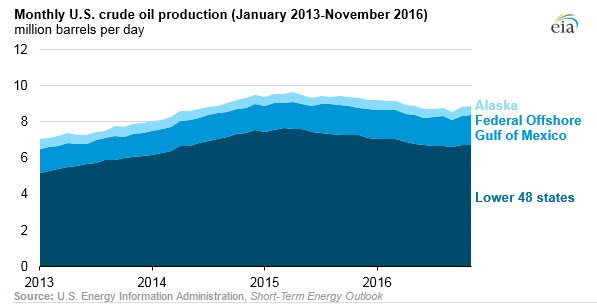WASHINGTON, Mar. 2, 2017 - U.S. crude oil production increased for the second consecutive month in November 2016, the first time this has occurred since early 2015, according to data from the Energy Information Administration (EIA).
Increased drilling activity in the Permian region, which spans Texas and New Mexico, as well as the start of a number of new projects approved during the 2012-2014 period in the Federal Offshore Gulf of Mexico (GOM), more than offset declining production from other regions in October and November 2016, EIA says.
The data show that increased drilling in the Permian region responded “relatively quickly” to a rise in the West Texas Intermediate (WTI) crude oil price, which increased from an average of nearly $30 per barrel in the first quarter of 2016 to $45/b or higher beginning in the second quarter of the year.
U.S. crude oil production averaged an estimated 8.9 million barrels per day (b/d) in 2016, and monthly U.S. crude oil production increased by 232,000 b/d in October and by 105,000 b/d in November, the agency says.
 Production in the lower 48 states increased by 104,000 b/d in October and decreased by 2,000 b/d to average 6.7 million b/d in November, the data show, while Gulf of Mexico production increased by 85,000 b/d in October and by 89,000 b/d in November.
Production in the lower 48 states increased by 104,000 b/d in October and decreased by 2,000 b/d to average 6.7 million b/d in November, the data show, while Gulf of Mexico production increased by 85,000 b/d in October and by 89,000 b/d in November.
Changes in Alaskan oil production make up the remaining differences, EIA notes.
In contrast to the Permian, the data show other onshore regions in the U.S. experienced year-over-year production declines in November. However, EIA notes that recent drilling activity suggests that production may be increasing in these areas as well.
According to oilfield service company Baker Hughes, the total U.S. oil-directed rig count has increased by 123 rigs since November 2016, with 39 percent of the increase occurring in regions outside of the Permian.
Current crude oil prices above $50/b, combined with increasing drilling rig counts in several onshore basins, suggest U.S. crude oil production will likely continue to increase, the agency says.
EIA’s February Short-Term Energy Outlook also forecasts year-over-year GOM production to increase by 30,000 b/d in 2017 and by an additional 140,000 b/d in 2018, to reach a total of 1.8 million b/d. Total U.S. crude oil production from the lower 48 states, the GOM and Alaska is expected to average 9.0 million b/d in 2017 and 9.5 million b/d in 2018, EIA notes.
#30

